2100whp twin-VR6T Volkswagen Golf GTI Mk4
After 20 years exploring the ragged edges of mechanical fatigue and evolving engine technology, Bruce Morehouse’s 2100whp twin-VR6T GTI has the world’s fastest Volkswagens in its crosshair. Words: Alex Grant Photos: Nathan Leach-Proffer.
MACHINE LEARNING
2100BHP
Our most powerful cover car to date, with twin VR6-turbo engines and over 1000bhp a pop!
Park your nostalgia for a moment and consider this; the 2020s might just be the golden era for performance tuning. Stood on the shoulders of a century of automotive R&D, we’re living in an age where genuinely fast cars are as accessible as they are diverse — from supercar-baiting modern hot hatches to engine-swapped classics and with every shade of grey in between. Just when you think you’ve seen the limits, along comes something to shake your expectations at their foundation.
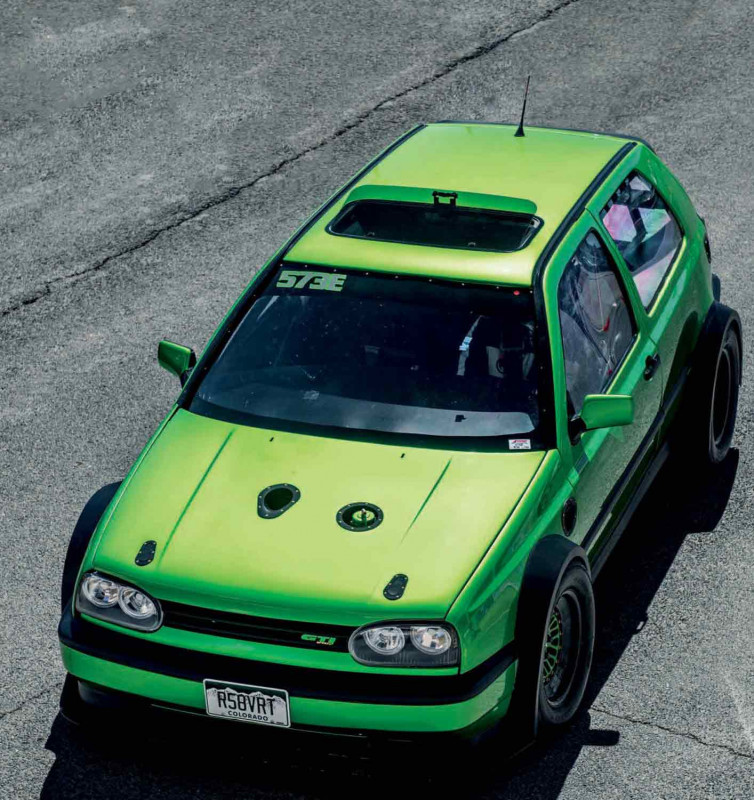
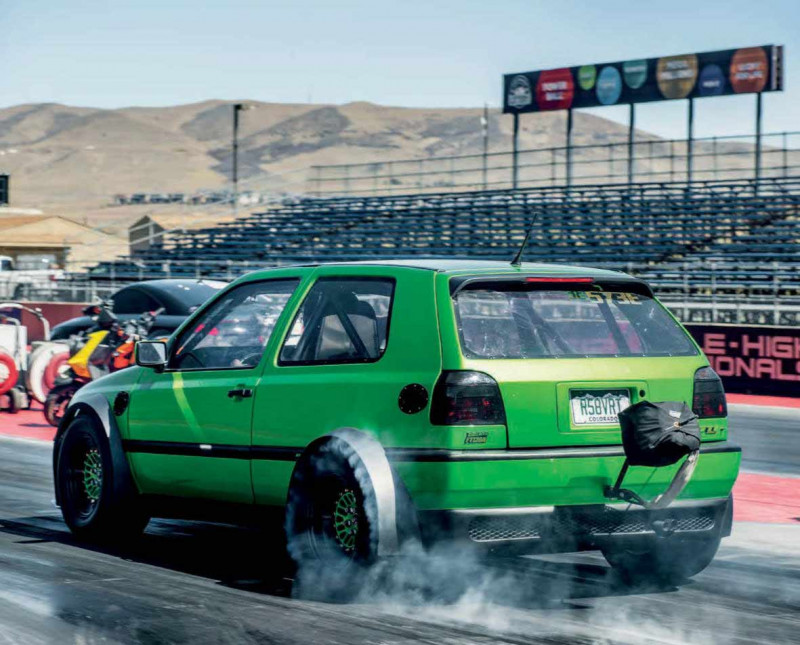
The headline stats behind Bruce Morehouse’s GTI could almost be mistaken for a typo; 12 cylinders, two huge turbochargers, 2,100 horsepower and (quite likely, by the time you read this) at least one world record too. Performance which would have been unachievable a decade ago, and unimaginable when the seed of inspiration was planted while he was growing up in Sarasota, Florida, back in the early 1990s.
“It all started in high school,” Bruce tells us. “All the rich kids had Mustang GTs and that sort of stuff, but I could never afford to get into one of those cars. I was working after school selling newspaper subscriptions door to door, so my first car was a 1982 Rabbit diesel. I got into Volkswagens because that was all I could afford, but I’ve always had one since. Once you get into a football team, that’s your team for life.”
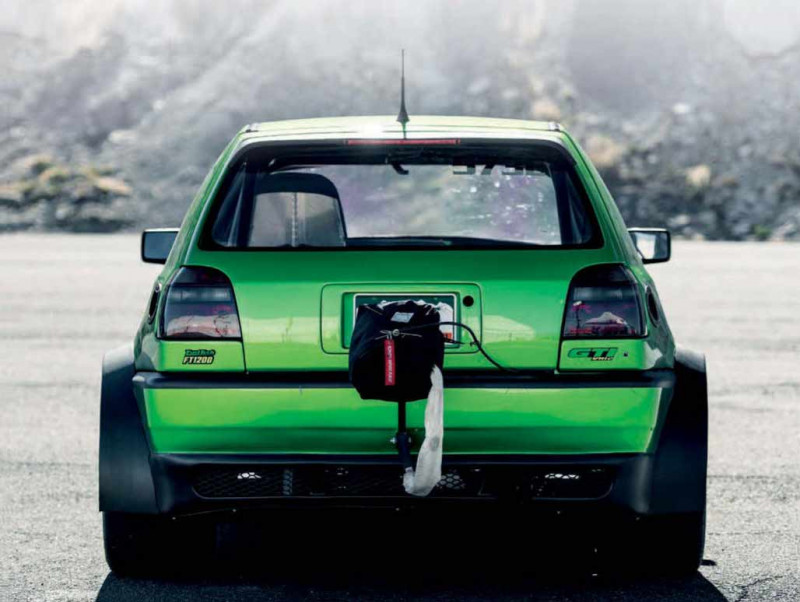
The Rabbit’s lack of cylinder count was a short-lived disadvantage. Bruce was training to become a mechanic, and a friend’s Dad happened to have an ’85 GTI specced for SCCA Road Racing, plus a stack of Volkswagen magazines to get his imagination going. Having sourced a wrecked Jetta GLI for its 16-valve engine and some carefully-chosen parts to help liberate a few more horses from it, the featherweight Rabbit quickly gained a talent for taking the local pony population down a peg or two. At least until he found something more challenging to get his teeth into.
“Where I grew up there was a 3/8-mile oval track, and they would hold NASCAR-style races with a class for four-cylinder cars – Toyotas, Dodges, stuff like that. Most of them were rear wheel drive, but I built a Mk2 as a circle track car, and I’d become so good at building fast Volkswagen engines that I put it into the winners’ circle many times. I did that for about five years.”
Of course, technology was moving on the meantime. By the late 1990s, a 16-valve swap wasn’t as close to the top of the Volkswagen performance food chain as it had been, and Bruce was keeping an eye on Mk3 GTI prices with plans to add a couple more cylinders. The VR6 was beginning to make big power more accessible, but would also require a different sort of track to show its full potential.
“I got into drag racing when the turbos got real big and you could get a VR6 up from 178hp to 350hp,” he continues. “It would have been back in 2000 or 2001 that I bought this car, as a stock Surf Green 2.0- litre GTI, and put a supercharged VR6 in it. Then I swapped that for home-made turbo conversion with DTA engine management when that came out, and finally added an SQS gear kit. That made it a ten-second front-wheel drive car. It was really fast.”
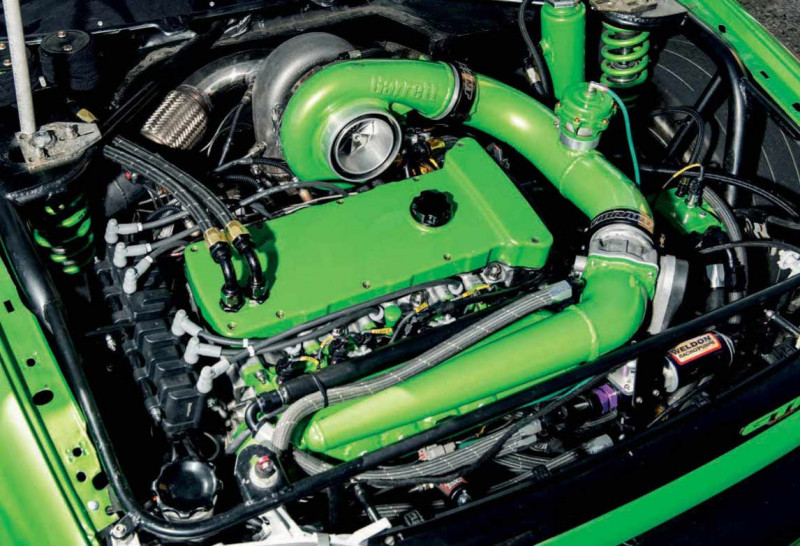
However, so was the pace of change in his own life. Momentum slowed while he started a family and, by the time drag racing had become an itch worth scratching again, the Golf wasn’t competitive enough to just pick up and carry on with. Front-wheel drive was already its biggest sticking point, powertrain technology had moved on again, and there was a nagging temptation to part it out and buy a V8 instead. But it wasn’t nagging enough to lure him away from reading up on twin-VR6 monsters like DubSport’s ‘Big Dub’ Mk3, and the Biox Performance Lupo, nor the engineering curiosity that came with taking the same path.
For all the guidance he could lay his hands on, this wasn’t a job to be taken lightly. Bruce cut out the entire floorpan, replacing it with a tubular structure to mount most of the front of a Mk3 VR6 where the boot once was. Braced in every direction across a tubular spine beneath the cabin, this also dials out almost all chassis flex – a characteristic important enough that he’s since computer-designed a similar structure to replace everything in front of the windscreen. There’s very little Golf left where you can’t see.
The two-year rebuild left plenty of time for the spec to evolve on the fly. Where possible, steel exterior panels were swapped for fibreglass to keep the weight down, and the body was media blasted before being painted a factory GM colour, so it can be repaired easily. The custom-made dashboard is a third lighter than a modified factory one and has access panels for the wiring and the hydraulic reservoirs behind, while the arch flares are Bruce’s own design. They provide enough space for ten-inch-wide slicks, and a visual link back to the GTI’s textured plastic bodykit.
“It’s basically a factory body, and all the fibreglass work and fender flares were done here at my shop,” he continues. “A lot of twin engine cars have hood scoops and things like that, but I wanted it to still look like a Golf. Like there was something funny about it, but you wouldn’t know what it was until you look inside.”
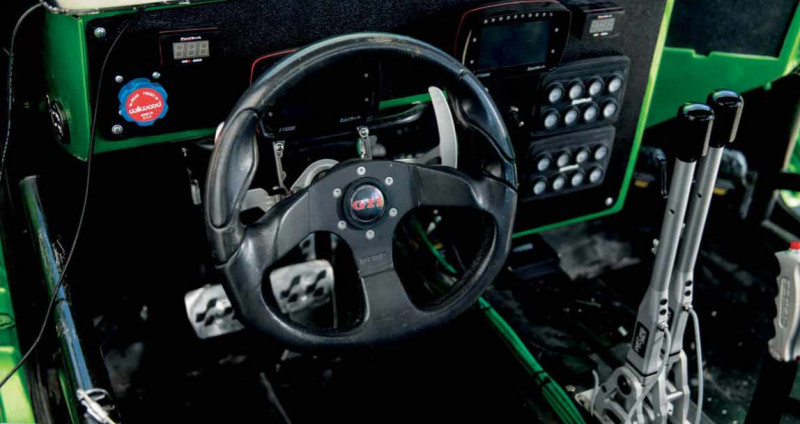
Any illusion of subtlety shatters if you open the doors or bonnet. The two 12-valve VR6 engines are near-identical, developed in tandem and putting out progressively higher power figures as turbocharging and management tech has allowed in the meantime. But the real enabler is the gearbox; the six-speed O2M could withstand big power figures better than the five-speed O2A he’d used before, while the sequential SQS setup overcame some of the technical challenges of synchronising two H-gates through the same stick. Both engines have their own shifter and hydraulic handbrake, which means the Golf can do front and rear wheel burnouts at the start line. The shifters are close enough to one another that they can be operated with one hand while it’s on the strip.
“I had all the problems you would get building a race car from scratch, but times two or times three,” laughs Bruce. “So the first year was trial and error. The first time I took it down the track, I broke a CV joint and didn’t get past 30 feet. Then the second time I broke the motor mounts. Every time, I would rebuild it stronger, and by the end of the first season I was getting it down the track. It was starting to feel good, and I was realising how fast it could really go.”
The Golf was straying into uncharted territory by this point, squatting onto its rear axle while launching and annihilating whatever happened to be the weakest link in the chain. Besides reinforcements to the structure, Bruce has been through several sets of stronger driveshafts and to get it where it is today, and some expensive failures along the way. Its specially made Kotouc gearboxes were fitted after an unplanned wheelie in 2018 lunched the rear transmission on the start line. Clutch bias is adjustable on the dashboard, releasing power to the rear tyres first to get it off the mark, then at the front to wind on extra grip, all meticulously controlled by cutting-edge management. That parachute isn’t for show, either.
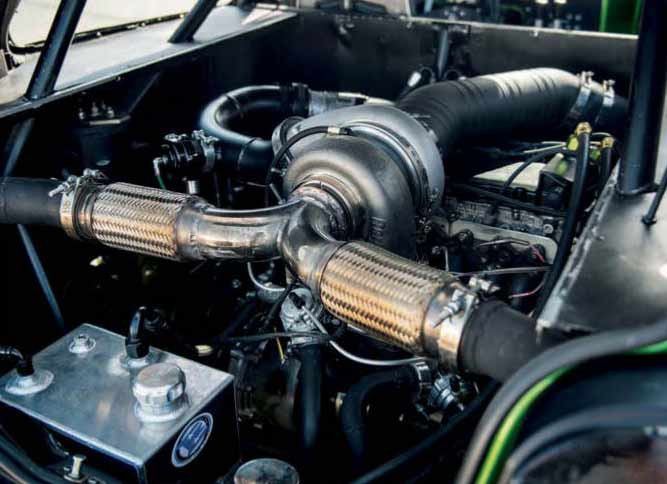
“It goes by so fast that all I can remember is letting out the clutch and launching the car, then pulling the chute,” says Bruce. “What happens in between is kind of a blur, and I’m just going by muscle memory. Every time I make a big jump in speed, I’ll use the chute to be safe. Sometimes I don’t need to use it, other times I’ve gone through the traps with the wheels spinning and I’m fighting to keep it straight, then I can’t wait to pull the chute.”
The unusual shifter setup has other advantages. Class requirements mean the Golf has to stay road legal, and it can be driven just using the front engine which (unlike the one in the back) has a full cooling pack, power steering pump and alternator. Not that you’ll get too far on the contents of a three-gallon fuel cell, of course. As the weak points were ironed out and his confidence grew, Bruce has chipped away at the quarter-mile times, setting an 8.3-second, 182mph personal best while still eyeing opportunities to improve.
“The engines have really accelerated this year, because I stopped trying to copy what the other Volkswagen guys are doing to make their cars fast. I’m applying knowledge from the big V8, big turbo guys, the really fast cars, and I’ve jumped way ahead of everybody in the country with a VR6 engine,” he explains. That methodical process of re-engineering the VR6 is all the more impressive when you remember it all had to be done twice. Every moving part within the overbored block is uprated, while the oil system was completely redesigned with a large, belt-driven external pump and machined galleys to improve lubrication of the crankshaft’s main bearings. CNC-machined heads from Veicomer in Portugal include dimpled valves for better atomisation and receiver grooves for the O-rings set into the block, sealing the combustion chamber more effectively under full load. The rebuild even went as far as filling the coolant channels in the rear block with a cement-based filler, for added strength.
«Every time I make a big jump in speed, I’ll use the chute just to be safe»
With post-2000s engine management improving at a pace Bruce likens to the gap between an Atari and a PlayStation 5, software is a vital component for keeping those mechanical parts in one piece. Living at 7,800ft (2,300 metres) above sea level required huge amounts of boost to wring all the power out of the engines, with a shot of nitrous and extra fuel injector to aid charge cooling. Each engine has a belt-drive mechanical fuel pump to feed its maniacal thirst for methanol, and there are seven O2 sensors per VR6 pumping out the information needed to get the fuelling right. That’s something no automotive Atari could ever process quickly enough.
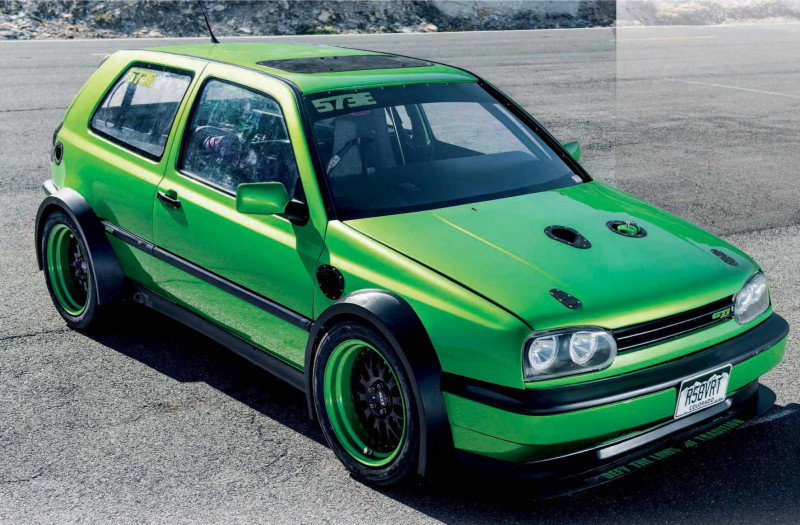
It’s dialled in performance at a brain-melting scale. Each engine puts down 1050hp at the wheels, despite Colorado’s altitude robbing them of almost as much power as a stock VR6 produces in total. At sea level they should be good for 1200whp apiece, without nitrous. It’s become a package so volatile that the blow-off valve has to dump its potentially fl ammable mix of methanol through a hole in the bonnet if the throttle is released quickly to avoid other sources of ignition. And while it’s heavier than that high school Rabbit, all of the Mk3’s brains-and-brawn weigh in at just 1300kg (2890lbs) – similar to a Mk8 with a quarter of the cylinder count on board.
So these days, it’s not just V8s he’s chasing down, and we’ve no reason to doubt the fighting talk: “Boba Motorsports has the world record at 8.19 seconds,” says Bruce. “With the engine and gearbox setup I have now, I’m confident that I can make a seven-second pass this summer, or at least by the fall, when the temperatures are cooler and the turbos work a lot better. Then I want to make a half-mile pass, the world record is around 210mph. World’s fastest Golf in the quarter and half mile would be good enough for me.” At least for now. Behind every record-setting build are teams of heads being scratched and late hours being worked behind workshop doors across the globe, and the arms race to re-set the bar is as aggressive as the pace of technological evolution that’s delivering it. No matter where you place yourself within those high-performance shades of grey, there’s a whole lot of combustion engine development still worth watching. Enjoy that golden era while it lasts.
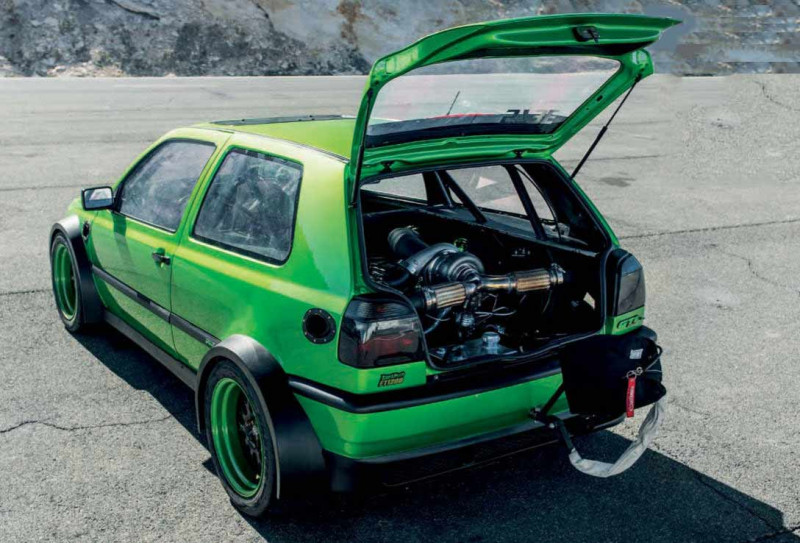
DUB DETAILS
- ENGINE: Both: Based on AAA 2.8-litre, 12-valve VR6, Madcap Racing machined block with stainless ‘O’ rings in the deck, balanced and polished factory crankshaft, King Racing bearings, custom 84mm Gibtech 11:1 pistons, R&R Rods custom aluminium conrods, custom Flatout Group copper head gasket, Veicomer full CNC race ported heads with dimple finish and beryllium seats and receiver grooves, Pro Series head studs, Supertech valves and springs, Cat Cams high lift turbo camshafts with solid lifters, adjustable cam gears, JDL Design exhaust manifold, Garrett G42-1450 79mm turbo, custom dual-plenum intake manifolds, Dodge Charger drive-by-wire throttle body, Mk5 R32 throttle pedal, MoTeC System exhaust, Tial wastegates and blow-off valves, modified iABED Industries aluminium sump with heater and pickup tube, iABED Industries belt-drive pulley with Fluidampr balancer, Aviaid belt drive wet sump high pressure pump, block modified for dual pressure feeds on the main and rod lines, enlarged oil line feeds, remote oil filter with 1x -12AN feed and 2x -10AN outlets for block and head, 7x Injector Dynamics 2,200cc injectors, -10 fuel rail dual feed, Weldon fuel pressure regulator, Weldon stainless steel fuel filters, Waterman Racing sprint-spec belt drive mechanical fuel pump, 2x three-gallon Boyd Welding fuel cells, methanol M1 fuel, Nitrous Outlet six-cylinder direct port dry nitrous kit and solenoid, Nitrous Outlet 12lb composite tank, 175hp nitrous jets with progressive controller, FuelTech FT600 ECU and dash display, FuelTech Input Expander, AEM pressure compensated O2 controllers, 2x FuelTech WB-O2 Nano wideband display and conditioner, 7x O2 sensors (one post-turbo, one per cylinder pre-turbo), 6x EGT sensors (one per cylinder), FuelTech EGT thermocouple controller, 6x FuelTech IGN1A inductive Smart Coils, Brisk Racing spark plugs, colour-coded turbo, boost pipes and cam cover, Kotouc six-speed fully sequential gearbox, Kotouc shifter with strain gauge, input shaft enlarged for Evo clutch, Clutch Masters Industries 9in twin disc race clutch with custom Mitsubishi Evo discs, custom-made Driveshaft Shop pro level driveshafts, hubs and CV flanges, Parker hydraulic clutch line flow control valves, Wilwood dual master cylinders with balance bar and adjustment knob for front/rear Front engine: Speedfactory aluminium radiator, dual Spal fans, KSE sprint car belt drive power steering pump, Eurowise mini alternator kit with electric water pump Rear engine: Block filled with Hard Blok cement-based filler, cooling system deleted, charging system deleted
- CHASSIS: Colour-coded 9x17” (front) and 11x17” (rear) CCW Classic three-piece wheels with 275/40 and 315/35 Toyo Proxes R888 R tyres (road), colour-coded 9.5x15” Weld Racing drag wheels with 15x10in Mickey Thompson slicks (track).Custom tubular chassis and front and rear with fabricated floorpan and half bulkhead, Koni adjustable coilovers with Eibach springs, Eibach sway bar, adjustable camber plates, Hanksville Hot Rods NHRA 8.50 legal roll cage, OE Mk3 front brakes (front and rear) with shaved calipers, parachute, 2x Hurst drift-spec hydraulic handbrakes (for front and rear line-lock)
- EXTERIOR: Fully media blasted and painted GM Synergy Green, custom fiberglass flares, Optiwerks fi breglass front bumper with light recesses deleted, Optiwerks side skirts, fibreglass hood with turbo scoop and blow-off valve exit, fibreglass rear hatch, fibreglass rear bumper, smoked Mk4-style headlights, Hella smoked tail lights, debadged grille, custom hood scoop, custom exhaust flanges, Aluminium front splitter, NHRA catch pans, custom VR12 badges by @renewart_lleida, 1/8in lexan polycarbonate windows and windscreen
- INTERIOR: Fully stripped interior, Momo steering wheel, Mitsubishi Evo X paddle shifters, custom dashboard, Racewire Solutions USB data bulkhead, 2x FuelTech SwitchPanel keypads, Kirkey aluminium bucket seat, G-Force Racing harness
- SHOUT: Bill Schimmel at Schimmel Performance for being my go-to guy throughout the years
“I had all the problems you would get building a race car from scratch, but times two"


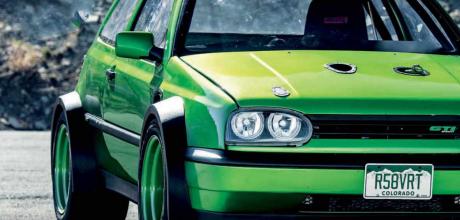
Mk4 — front grille